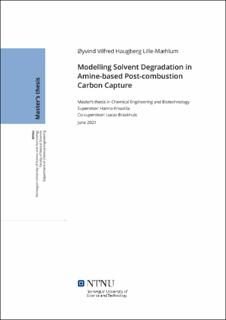| dc.contributor.advisor | Knuutila, Hanna | |
| dc.contributor.advisor | Braakhuis, Lucas | |
| dc.contributor.author | Lille-Mæhlum, Øyvind Vilfred Haugberg | |
| dc.date.accessioned | 2021-11-19T18:21:08Z | |
| dc.date.available | 2021-11-19T18:21:08Z | |
| dc.date.issued | 2021 | |
| dc.identifier | no.ntnu:inspera:82941058:18515270 | |
| dc.identifier.uri | https://hdl.handle.net/11250/2830558 | |
| dc.description.abstract | Aminbasert karbonfangst er en teknologi som kan redusere de stadig større menneskeligskapte CO2-utslippene. Det er likevel to problemer med denne teknologien. For det første vil løsningsmiddelet som brukes for å reagere med CO2 brytes ned. Det andre problemet er at prosessen krever store mengder energi. Videre forskning bør bli gjort for å forstå nedbrytningen av løsningsmiddelet mens man minimerer energibehovet i prosessen.
I denne masteroppgaven ble to modeller brukt for å estimere mengden av løsningsmiddelet Monoetanolamin (MEA) som blir nedbrutt i en eksperimentell rigg, i et pilotanlegg for karbonfangst og i to industrielle anlegg.
Modellene ble validert ved å sammenligne nedbrytningen som ble målt fra en eksperimentell rigg i labskala, og med nedbrytningen som ble målt ved et pilotanlegg. Det viser seg at den avanserte modellen var mest nøyaktig for riggen, mens den enkle modellen egnet seg best for pilotanlegget. Konsentrasjonene av komponentene som stammet fra nedbrytningen, HEI, maursyre, HEEDA og HEIA som den avanserte modellen estimerte var nokså nøyaktig sammenlignet med eksperimentet i riggen.
Fra sammenlikning mellom røykgass fra et kullkraftverk og et kraftverk basert på naturgass ble det funnet mest nedbrytning ved å rense røykgassen fra kullkraftverket. Det energimessig optimale forholdet mellom løsningsmiddelet og røykgassen ble funnet til 2,6 for kull og 1,1 for naturgass. Den avanserte modellen beregnet et MEA-konsum for et typisk 400 MW kullkraftverk til 0,35 kg MEA/tCO2, mens for naturgass var det 0,25 kg MEA/tCO2. Den enkle modellen beregnet 0,55 og 0,37 kg MEA/tCO2 for henholdsvis kull og naturgass. Basert på de nokså like energibehovene kunne det fastslås at det er mest økonomisk gunstig å installere karbonfangstteknologi på kraftverk basert på naturgass. | |
| dc.description.abstract | Amine-based Post-combustion Carbon Capture (PCC) is a promising way of reducing the constantly increasing anthropogenic CO2 emissions. In this process, there are two significant problems. The first problem is solvent degradation, and the second problem is the considerable energy consumption this process requires. Further research should be done to fully understand and reduce solvent degradation while at the same time minimising the energy consumption of the process.
In this master thesis, two degradation models were used to predict solvent degradation of Monoethanolamine (MEA). These models were evaluated on a lab-scale experiment, a pilot plant, and two industrial cases.
The models were first validated by comparing the observed degradation seen at lab-scale experiment and the pilot plant. The advanced model predicts an MEA loss which was comparable to the lab-scale experiment. The simplified model fits best for the pilot plant. The prediction of the degradation compounds HEI, formic acid, HEEDA, and HEIA seem to fit relatively close to what was found at the lab-scale experiment.
By comparing flue gases emitted by a coal and a natural gas-based power plant, solvent degradation was found to be most significant for coal. The optimal liquid-to-gas ratio concerning energy consumption was found to be 2.6 for coal and 1.1 for natural gas. The specific MEA consumptions from typical 400 MW coal and natural gas-based power plants were found to be 0.35 and 0.25 kg MEA/tCO2, respectively, by the advanced model. The simplified model predicted the specific MEA consumption to be 0.55 and 0.37 kg MEA/tCO2, for coal and natural gas, respectively. Based on similar specific energy consumption in the two cases and based on the model's prediction on degradation, flue gases from natural gas might be most economical in terms of operating expenses in an amine-based post-combustion carbon capture plant. | |
| dc.language | eng | |
| dc.publisher | NTNU | |
| dc.title | Modelling Solvent Degradation in Amine-based Post-combustion Carbon Capture | |
| dc.type | Master thesis | |
